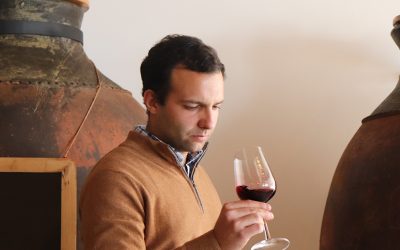Sparkling Wine Vidigueira in Diário do Alentejo
Journalist Manuel Baiôa wrote for Diário do Alentejo about Alentejo sparkling wines, including our Espumante Vidigueira, a sparkling wine sourced 100% from the antão vaz grape variety: “Sparkling wine sales are growing worldwide and Alentejo producers could not be left out of this trend that is also having an impact in Portugal.”

Full article:
Sparkling wines from Alentejo in Diário do Alentejo, 3.1.2020
Sparkling wine sales are growing worldwide and the Alentejo producers could not be left out of this trend that is also having an impact in Portugal.
The consumption of sparkling wine was in the recent past very limited to birthday parties, where a poor quality sweet sparkling wine was drunk together with cakes, or else sales were limited to the end-of-year parties. Today, fortunately, Portuguese consumers are more informed and demanding, and the consumption of quality dry and brut sparkling wines has grown enormously. Raw sparkling wine, that is, without added sugar, is a versatile drink that can accompany meals from appetizers to desserts, accompanying meat and fish with great class. The Alentejo dominates the national wine market and therefore could not be left out of this growing trend in the consumption of “bubbles”.
The regions with the longest tradition in sparkling wine production in Portugal are located in the north, in cooler areas, particularly Bairrada and Távora-Varosa, although sparkling wines are now produced throughout the country. The production of sparkling wine is associated with colder areas, because to make a good base wine for sparkling wine it is necessary that the wine has a low alcohol content and an adequate acidity and pH, which is not easy to achieve in the Alentejo. Hence, many critics claim that the Alentejo’s climate is not conducive to making quality sparkling wines. Most of the Alentejo producers we consulted agree that sparkling wine production in the Alentejo is demanding and requires great attention to the harvest date, which is usually early.
Óscar Gato, winemaker at Adega de Borba, argues that “to produce a wine with lower alcohol content or to produce a wine with a higher level of total acidity, it will always be a question of deciding to harvest at the most advisable time. On the other hand, “in the vineyard we look for grapes coming from grape varieties with higher acidity, from vineyards exposed on a northern slope, with greater freshness, grapes harvested early in the morning, with lower temperature in the grape berries, with lower sugar content so that we can privilege and emphasize the balance of the wine.
Sofia Uva, export manager of Herdade da Mingorra, says that when making their sparkling wines they pay special attention to “the choice of varieties, the types of soil, and the location of the parcels. They also have “concerns about hedging and leaf area, and don’t use bunches that are too exposed to the sun,” in addition to harvesting earlier to preserve freshness.
Sandra Sárria, winemaker of Sexy sparkling wines, from Fita Preta, reveals that they choose “indigenous Alentejo grape varieties that are late, have nine-ten percent alcohol and a perfect acidity for sparkling wines. The traditional bancas varieties are not very aromatic and for this reason are very interesting for the production of base wines for sparkling wines. In rosé we take advantage of the bunch weeding in the reds, which is done in order to obtain the perfect ripeness, in which the alcohol content is still low and the acidity is high”.
Cátia Fonseca, marketing manager at Ribafreixo, points out that the quality of their sparkling wine is largely derived from their vineyards, which are integrated in the Sub-Região DOC de Vidigueira, as this region has “a unique microclimate”, with “perfect sun exposure, hot and dry summers, tempered with a cool breeze from the Atlantic and a significant variation between night and day temperatures. These characteristics combined with the schist terroir of our estate, give rise to wines that are quite fresh, mineral and with a very balanced acidity.
Daniela Almeida from the Marketing department, Adega Cooperativa de Vidigueira, Cuba e Alvito emphasizes that the several awards won by their sparkling wine are due, among other reasons, to the “selection of grapes that, in those years, presented the most balanced maturation parameters for sparkling wine production, namely in what concerns the balance between acidity and sugars”.
Our tasting of Alentejo sparkling wines shows that consumers should have confidence in this new product that is starting to be part of the portfolio of most companies in our region, because they have proven to be aromatic, fresh and creamy and are the perfect match for most of the Alentejo cuisine.




